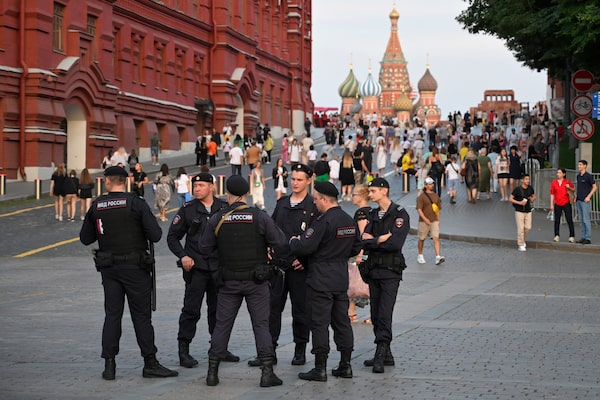
Police officers stand near the Red Square in Moscow on Aug. 1.Dmitry Serebryakov/The Associated Press
The glittering towers of the Moscow City business district dominate the skyline of the Russian capital. The sleek glass-and-steel buildings – designed to attract investment amid an economic boom in the early 2000s – are a dramatic, modern contrast to the rest of the more than 800-year-old city.
Now they are a sign of its vulnerability, following a series of drone attacks that rattled some Muscovites and brought the war in Ukraine home to the seat of Russian power.
The attacks on Sunday and Tuesday aren’t the first to hit Moscow – a drone even struck the Kremlin harmlessly in May. But these latest blasts, which caused no casualties but blew out part of a section of windows on a high-rise building and sent glass cascading to the streets, seemed particularly unsettling.
“It’s very frightening because you wake up at night hearing explosions,” said a woman who identified herself only as Ulfiya as she walked her dog, adding that she lived in a nearby building. Like other Muscovites interviewed by The Associated Press, she did not identify herself further out of fear of retribution or for her personal safety.
Another resident, who gave her name as Ekaterina, said Tuesday’s blast “sounded like thunder.”
“I think for the first time, I got really scared,” she said. “I don’t understand how people in a war zone can live like this every day and not go mad.”
The Russian Defence Ministry said it shot down two Ukrainian drones outside Moscow and had electronically jammed another, sending it crashing into the IQ-Quarter skyscraper that houses government offices like the Ministry of Economic Development, the Ministry of Digital Development and Communications, and the Ministry of Industry and Trade – the same building that was hit Sunday.
A cordon went up around the building and personnel from the fire department and the Russian Investigative Committee were at the scene. Hours later, residents strolled through the district along the Moscow River or sat on benches in the sunshine. By about 1 p.m. Tuesday, workers were already starting to replace damaged windows.
The business district, a 10-minute subway ride west of the Kremlin, is home to some of Moscow’s flashiest restaurants, offering far-reaching views of the capital and a menu of upscale fare like three types of caviar, shellfish from Russia’s Far East and French cuisine.
But there was no escaping the grim news.
While Russian state television has largely played down the strikes, one channel sandwiched a segment on how Moscow’s air defences successfully intercepted the drones in between reports highlighting Russian attacks on Ukraine.
Mykhailo Podolyak, an adviser to President Volodymyr Zelensky, said in Ukraine that Moscow “is rapidly getting used to a full-fledged war,” without confirming or denying Kyiv’s involvement in the drone attacks that in recent days have struck from the capital to the Crimean Peninsula.
After Sunday’s strike, the Kremlin said security would be ramped up.
Still, the size of the drone that hit the Moscow City district led analysts to question the effectiveness of the capital’s air defences, suggesting it could have been launched from Ukraine.
“If this is the case, this would be rather embarrassing for Russia’s air defences. If a drone has been in Russian airspace for hours, air defences should have picked it up earlier and shot it down earlier,” said Ulrike Franke, an expert in drones and military technology at the European Council on Foreign Relations.
While they haven’t caused much physical damage, bringing the drone campaign to Moscow “blows holes in Russia’s narrative that the war on Ukraine is successful and that it is being prosecuted far away from any consequences for the Russian people themselves,” said Keir Giles, a Russia expert at the Chatham House think tank in London.
“That is something which is going to be harder and harder for Russia’s propaganda machine to explain away,” he said.
A Muscovite who identified himself to the AP only as Eldar summed up the strikes this way: “We attack them, they attack us. And it’s obvious that they will succeed somewhere, and we will succeed somewhere. We should try to strengthen the defence.”
In Odintsovo, where some of the drones were downed about 30 kilometres (18 miles) southwest of the capital, some residents discussed the events on their local Telegram channel.
One woman talked about hearing noises that turned out to be a car or improperly closed trash containers, and seeing what she thought were drones but actually were a flock of birds, a plane and a wind-blown plastic bag.
“How is it possible to live like this?” she asked the group.
“Stop creating panic,” one member admonished her.
“If you hear a noise, be happy because it hasn’t hit you,” added another.